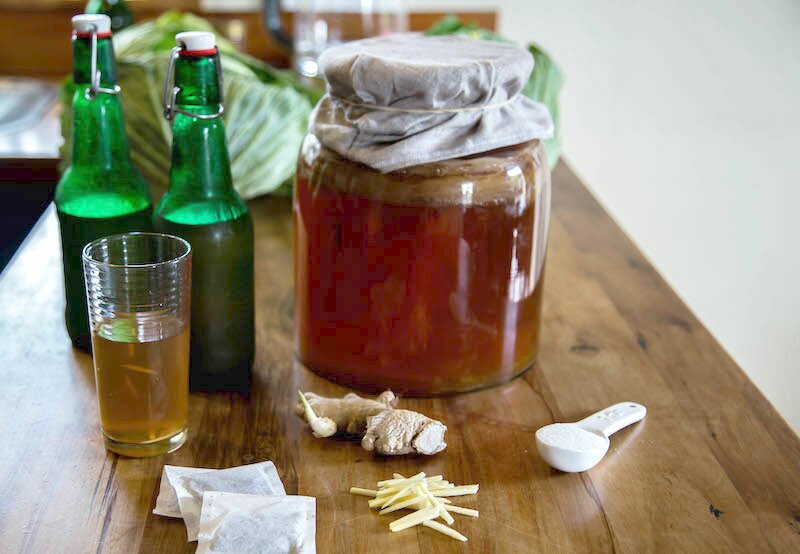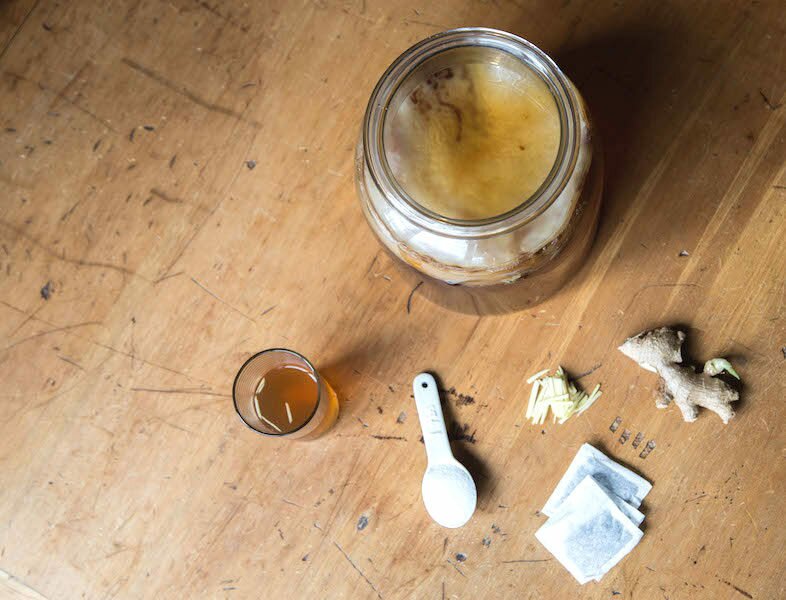My husband tells me he has some colleagues at work who are awaiting this post with interest. After the Christmas/New Year holidays in December and January, it was observed by his colleagues that he had lost a noticeable amount of weight since they had last seen him. He was never really overweight as such; just getting the approaching-middle-age-extra-padding-around-the-middle that usually starts to make an appearance around our age 😉 . It is now May, and since December-ish my husband has lost over 20kg without any major effort on his part. He credits the regular drinking of kombucha to his improved physique, although personally, I think it more likely to be the result of him eating a lot less processed food. Logically, it seems most likely that his improved weight and body-shape is a result of combined efforts to eat less processed food (what I consider to be ‘dead’ food), eat more ‘living’ food, and reduce our exposure to unnecessary chemicals. Whatever the reason, he has aroused the curiosity of his colleagues with this mysterious ‘kombucha’ drink, which he takes to work every day in a Grolsch bottle, and drinks like a beer!
Kombucha is a fermented tea drink, and it is making its way into organic shops and fashionable eateries everywhere! Depending on which teas are used and what natural flavourings are added after the ferment (we use ginger), it can taste quite different each time you drink it. We like to keep it simple and we use black tea every time, adding fresh chopped ginger for zing and flavour. The resulting naturally fizzy drink tastes something like ginger ale, ie. refreshing and delicious. It’s not particularly high-maintenance, as we attend to it only every 10 days (that’s when it has the flavour we like) and it takes us about half an hour to bottle up enough to last us till the next batch.
I’ll explain what it is by describing the process of making it. First, we brew a pot of sweet black tea. The tea needs to be sweetened, preferably with white (we use organic) sugar, and then cooled to room temperature. We pour this sweet tea into a glass vessel with a large opening (it needs air to get fizzy), add some kombucha from our last batch, and then carefully place the SCOBY into the jar so it floats on the surface of the liquid. It can sink to the bottom, usually because of the temperature of the tea, but it tends to float back up to the surface and hang out there. The SCOBY (Symbiotic Colony Of Bacteria and Yeast) is a sort of rubbery, stack-of-pancakes like thing that feeds off the sugar and ferments your tea for you. We then cover the vessel with a cloth and a rubber band and leave it on a sun-less shelf undisturbed for 10 days. The fermented tea we now have gets poured into empty Grolsch bottles with a few sticks of fresh ginger, is left on a shelf for a day, and then transferred to the fridge until we’re ready to drink it.

So, what makes this drink so amazing? Well, it is important to note that even after you remove the SCOBY, the kombucha drink is ALIVE. This is actually the main reason we transfer it to the fridge. If it’s nice and warm, and you leave your bottles out at room temperature, the kombucha will continue to ferment, albeit more slowly. The carbonation can cause so much pressure that opening a bottle will result in an explosive mess (and bang!) if you don’t release it slowly (I have wiped kombucha off the ceiling more than once :-/ ). This is why we choose to use Grolsch bottles to store ours.
Anyway, the living bacteria and yeast in kombucha are what make it amazing. The idea is that in introducing beneficial bacteria to your gut, your body can maintain a healthy equilibrium of good and bad bacteria all on its own (the word ‘empowerment‘ springs to mind here). Certainly during my lifetime, I feel we have been encouraged to use the bazooka approach as the most effective way to combat ill health, ie. using antibacterials on and in our bodies to seek out and destroy all bacteria, bad as well as good. However, there is a growing awareness now that antibiotic use has long-term negative consequences that we hadn’t really taken into consideration until quite recently. We are learning that most of our immune system is operating from within our guts, and that our guts need a balance of both good and bad bacteria in order to function well. Unnecessary use of antibacterials, including antibiotics (not just as as prescribed by medical practitioners, but also from some foods such as meat, and from soaps, sanitisers and other personal hygiene products), combined with the simple, unvarying diet that comes from eating processed foods, and an over-clean, sterile living environment, means that many of us have difficulty not only in keeping the bad bacteria in our bodies from over-populating, but also in sustaining a healthy population of good bacteria inside us.
Consuming fermented foods is one way of introducing more good bacteria into our bodies, in a way we can manage ourselves. What I mean by this is that if we feel and listen to how our bodies respond to what we’re eating, we can eat just the right amount of fermented food that suits us. Too much good bacteria is just as stressful for our bodies (particularly if they’re used to depleted levels) as not enough! I know this from experience. I was initially so enthusiastic about consuming my kefir, kombucha, and sauerkraut, that my own body felt pretty miserable for a few months until I figured out that I can only cope with a half glass of kombucha every now and then. My husband, on the other hand, enjoys at least a bottle of it a day! And rather than feeling the worse for it, he’s felt fantastic for drinking all that kombucha right from Day One.
But you see, we’re all different. Just like our ferments. And that’s something we should celebrate and accommodate, by learning to understand our individual qualities and needs. The good things in life need constant attention and nurturing in order for them to flourish. Learning about, and engaging with, living foods like kombucha helps to remind us of that.

If you’re interested in having a go at making kombucha, you should know that SCOBYs are constantly regenerating. That means that they (like excess kefir grains) need to be culled constantly. Therefore, you needn’t go out and buy a SCOBY. You can most likely find one by asking around. Most people who are into kombucha-making are very keen to share the love, and will happily give you a SCOBY and some kombucha to start your own batch. I’ve put together a kombucha kit which includes a 3L (lead-free) glass vessel, handmade linen cover and teabag, optional 6x glass flip-top bottles, and comprehensive instructions on what to do and what not to do – this is available for sale in the Mrs Goodness Shop! If you live here in Hamilton I can also give you a SCOBY, or if you live elsewhere in NZ I can ask around for one on your behalf via my Instagram or Facebook pages 🙂 .
Also, if you’re interested in understanding the role of gut bacteria in managing our health, I think this article gives a good overview:
http://articles.mercola.com/sites/articles/archive/2012/06/27/probiotics-gut-health-impact.aspx